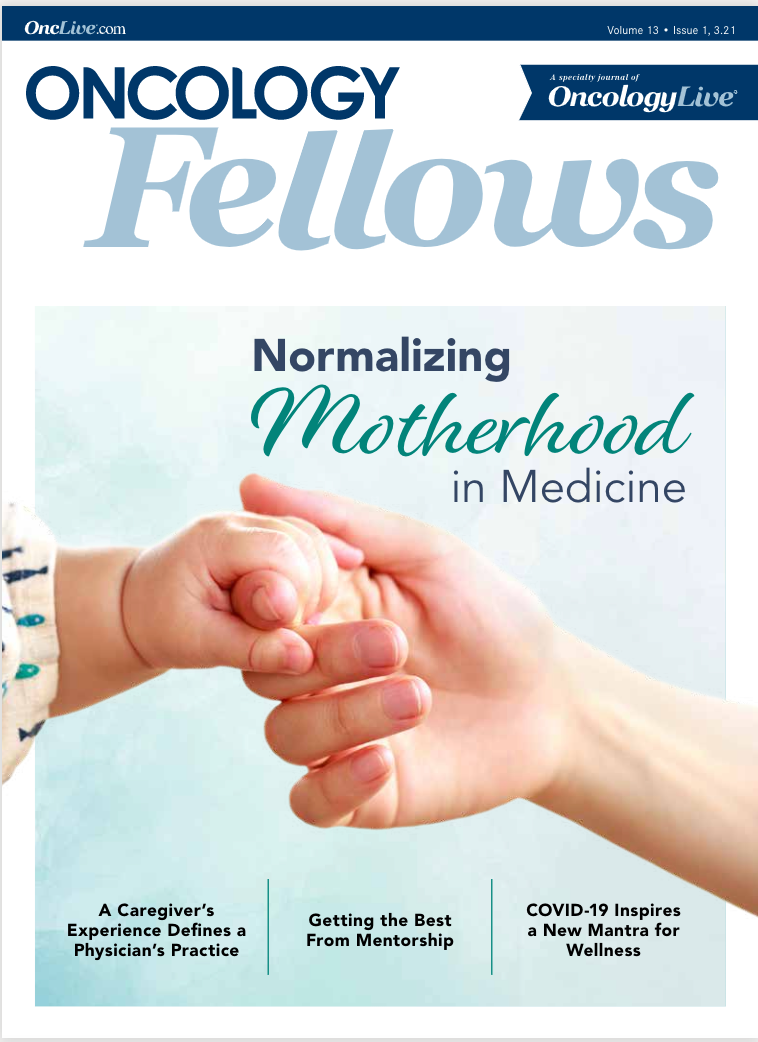Publication
Article
Oncology Fellows
Normalizing Motherhood in Medicine
Hematology/oncology programs can make it easier and more rewarding for would-be mothers to participate in fellowship.
Laura Van Metre Baum, MD

"Find mommy a good job," we were told. We both came to hematology/oncology fellowship as mothers of small children and, more unusually, worked as primary care physicians before that. The significant progress of women in medicine and the changing culture of medical training have enabled nontraditional applicants like us to gain entry into competitive subspecialty positions in areas such as hematology/oncology. The boys’ club of medicine is becoming extinct as talented women gain leadership positions in institutional medicine. Academic medicine is unquestionably more welcoming of mothers as trainees and faculty than was the case a generation ago.
However, maternal discrimination in the medical field requires continued attention. Physicians who prioritize balancing their family’s well-being with professional advancement risk being dismissed as unserious.1 The structure and culture of medical training presume, at most, limited family responsibilities, as trainees are expected to work extended and unpredictable hours and complete research on nights and weekends. Gap years, slowdowns, or time off track may be interpreted as a lack of commitment to the field. Residencies are structured such that a single resident’s maternity leave disrupts the whole program. Pay discrepancies, gender-related job expectations, and unrealistic expectations during pregnancy and post partum remain the norm.2
Medical training spans more than a decade, usually through the prime of women’s reproductive years. Although men in medical training also face difficult decisions about balancing family life with career, a gender differential remains. Biological concerns about fertility and the physical toll of pregnancy, birth, and lactation fall primarily on women. Culturally, men are more likely to rely on a partner to be a young child’s primary caregiver; men are more likely to have a “doctor’s wife” who has or assumes a more flexible career.3,4 Of course, having children is common for men and women alike and usually joyous. Being a doctor mom is normal and being or becoming a parent during training should be feasible, despite the challenges it presents for finances, long hours, childcare requirements, and geographic mobility.
Options for timing childbearing with career advancement include the following:
- Taking a gap year during medical school. Time off risks long-term career derailment, but this option benefits family life and one’s focus during training. It is, however, logistically difficult and expensive, and difficult to repeat with subsequent children. Furthermore, one then has a toddler during residency.
- Having children during training. This is common but arduous. Maternity leave is usually no more than 6 weeks and must be paid back, complicating placement (and paternity “leave” is generally 48 hours). Given the call structure, colleagues are forced to shoulder the extra burden of one’s absence, which can engender hostility and lead to guilt and distress.
- Having children while in a junior faculty position. Faculty are on a clock, biologically and professionally. The risks of infertility increase with age and opportunities for midcareer advancement can be capricious, meaning new mothers may be passed over unfairly.
Kathryn Kline, MD, MPH

We can speak to these challenges personally. Dr Kline had her first child during residency, sometimes working more than 100 hours a week while pregnant and pumping breast milk in call rooms while charting. Her second child was born during her years as a primary care physician with a relatively predictable office schedule.
With her daughters, Dr Baum utilized a modified gap year strategy; her older child is a “chief-year baby.” Chief year is a very popular time to have children, though it presents challenges such as a short maternity leave. Her second was born at the end of a palliative care fellowship, prompting off-cycle payback of her leave. Supportive spouses and full-time childcare have helped them to complete hematology/oncology fellowship with young children.
As they say, there is no good time to have children. However, the degree of adversity physician-mothers often experience is mostly unnecessary. Many of the challenges facing mothers in medicine reflect ingrained societal and medical cultural norms and apply to professional women more broadly. Research demonstrates that women are promoted based on accomplishments, whereas men are rewarded for potential.5 This inequality is exacerbated by delays incurred by women while having and raising children. New research in labor economics shows that “childbirth penalties” account for around two-thirds of the earnings gap for mothers in their mid-tolate 30s relative to women without children. Furthermore, the presence of female leadership does not mitigate this gap.6
Conversely, when men become fathers, they are rewarded financially and perceived as mature and responsible.7 In medicine, male physicians receive more professional respect: They are promoted earlier, hold more leadership positions, and are called Doctor more often.8,9 Colleagues and supervisors more readily perceive men as competent and self confident, rewarding them with respect and positions of influence.10
Men often receive authorship credit for their research efforts earlier in their training, and are informally credited for their contributions to collaborative work.11,12 Men are steered into more prestigious and lucrative specialties, within which male subspecialists make significantly more money.13,14
Finally, the ongoing negative impact of sexual harassment, bullying, and intimidation in medicine is alarming; nearly half of medical trainees report experiencing harassment.15-17 In a recent study at a large US academic medical center, most female faculty reported gender-based harassment within the past year; more than 80% reported harassment from fellow staff members and more than 60% reported harassment from patients. Experience of gender-based harassment was associated with worse mental health and lower job satisfaction.18
Our predecessors faced overt discrimination in medical school admissions, the Match, and hiring decisions, as well as hazing and a lack of role models. We benefit from the visibility of women as senior faculty, physician-scientists, and leaders and from the mentorship of men and women alike. Years of legal and institutional changes have made great strides in promoting gender equity, and persistent attention to these issues promotes continued improvement. Continuing to address institutional, cultural, and interpersonal factors that support women in academic medicine will create space for diverse female oncologists whose experiences will enrich their research, teaching, and clinical care. The ongoing shift to value and accommodate diversity can lead to an oncology workforce that better understands and responds to patients’ needs.19
We believe that hematology/oncology is an excellent career for physician-mothers. Recognizing and accommodating talented female physicians in their early careers can help prevent the female “brain drain” out of academia and the invisibility of mid-career women faculty, thus fostering the significant long-term contribution of these skilled physicians.20
References
- Templeton K, Bernstein C, Sukhera J, et al. Gender-based differences in burnout: issues faced by women physicians. NAM Perspectives. 2019. https://nam.edu/gender-based-differences-in-burnout-issues-faced-bywomen-physicians/
- Halley MC, Rustagi AS, Torres JS, et al. Physician mothers’ experience of workplace discrimination: a qualitative analysis. BMJ. 2018;363:k4926. doi:10.1136/bmj.k4926
- Staiger DO, Marshall SM, Goodman DC, Auerbach DI, Buerhaus PI. Association between having a highly educated spouse and physician practice in rural underserved areas. JAMA. 2016;315(9):939-941. doi:10.1001/jama.2015.16972
- Baptiste D, Fecher AM, Dolejs SC, et al. Gender differences in academic surgery, work-life balance, and satisfaction. J Surg Res. 2017;218:99-107. doi:10.1016/j.jss.2017.05.075
- Player A, Randsley de Moura G, Leite AC, Abrams D, Tresh F. Overlooked leadership potential: the preference for leadership potential in job candidates who are men vs women. Frontiers in Psychology. 2019;10(755). doi:10.3389/fpsyg.2019.00755
- Murray S. SD, and Staiger M. Female executives and the motherhood penalty. Working Paper CES-21-03. January 2021. Accessed March 9, 2020. bit.ly/3c9SnlS
- Glauber R. Trends in the motherhood wage penalty and fatherhood wage premium for low, middle, and high earners. Demography. 2018;55(5):1663-1680. doi:10.1007/s13524-018-0712-5
- Richter KP, Clark L, Wick JA, et al. Women physicians and promotion in academic medicine. N Engl J Med. 2020;383(22):2148-2157. doi:10.1056/NEJMsa1916935
- Duma N, Durani U, Woods CB, et al. Evaluating unconscious bias: speaker introductions at an international oncology conference. J Clin Oncol. 2019;37(36):3538-3545. doi:10.1200/JCO.19.01608
- Guillén L, Mayo M, Karelaia N. Appearing self-confident and getting credit for it: Why it may be easier for men than women to gain influence at work. Human Resource Management. 2018;57(4):839-854. doi: 10.1002/hrm.21857
- Feldon DF, Peugh J, Maher MA, Roksa J, Tofel-Grehl C. Time-to-credit gender inequities of first-year PhD students in the biological sciences. CBE Life Sci Educ. 2017;16(1). doi:10.1187/cbe.16-08-0237.
- Sarsons H, Gërxhani K, Reuben E, Schram A. Gender differences in recognition for group work. Journal of Political Economy. 2021;129(1):101-147. doi: 10.1086/711401
- Rotenstein LSaJD. How to close the gender pay gap in U.S. medicine. Harvard Business Review. November 4, 2019. Accessed March 8, 2020. bit.ly/38nPaOj
- Paturel A. Closing the gender pay gap in medicine. AAMC Diversity and Inclusion Workforce Research. April 16, 2019. Accessed March 8, 2020. bit.ly/3t1RmTK
- Choo EK, Byington CL, Johnson NL, Jagsi R. From #MeToo to #TimesUp in health care: can a culture of accountability end inequity and harassment? Lancet. 2019;393(10171):499-502. doi:10.1016/S0140-6736(19)30251-X
- Jagsi R. Sexual Harassment in Medicine - #MeToo. N Engl J Med. 2018;378(3):209-211. doi:10.1056/NEJMp1715962
- National Academies of Sciences E, Medicine. Sexual harassment of women: climate, culture, and consequences in academic sciences, engineering, and medicine. Washington, DC: The National Academies Press; 2018. 10.17226/24994
- Vargas EA, Brassel ST, Cortina LM, Settles IH, Johnson TRB, Jagsi R. #MedToo: A large-scale examination of the incidence and impact of sexual harassment of physicians and other faculty at an academic medical center. J Womens Health (Larchmt). 2020;29(1):13-20. doi:10.1089/jwh.2019.7766
- Gomez LE, Bernet P. Diversity improves performance and outcomes. J Natl Med Assoc. 2019;111(4):383-392. doi:10.1016/j.jnma.2019.01.006
- Is academic medicine making mid-career women physicians invisible? J Womens Health. 2020;29(2):187-192. doi:10.1089/jwh.2019.7732










